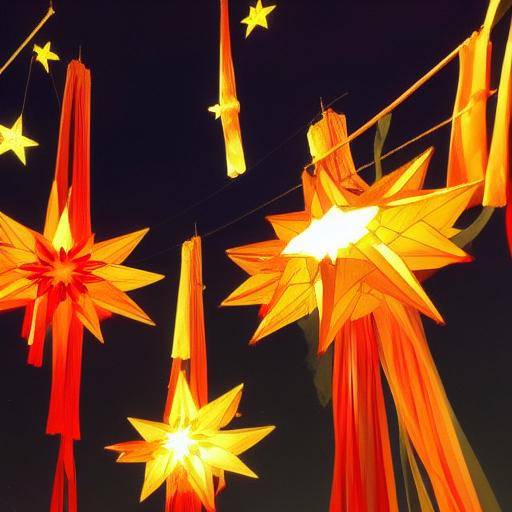
Tanabata, also known as the Star Festival, is a traditional Japanese celebration that takes place on the seventh day of the lunar calendar month. This colorful and unique festival is wrapped in beautiful legends and traditions, and is a special occasion to express wishes, admire the Milky Way, and enjoy stunning decorations. In this article, we will thoroughly explore each of these aspects, learning about the history and meaning of Tanabata, as well as the customs and activities associated with this fascinating festival.
Introduction
The Tanabata Festival, known as "The Star Meeting", is a celebration that has been transmitted over generations in Japan, and its origin goes back to an ancient Chinese legend that tells the story of two lovers separated by the Milky Way that are only allowed to meet once a year during Tanabata.
History and Background
The origin of the Tanabata Festival in Japan dates back to the Heian period (794-1185). During that time, Tanabata was celebrated as a way to promote writing skills, poetry and artistic expression. The legend of Orihime (the Vega Star) and Hikoboshi (the Altair Star) became the central theme of the festival, symbolizing the story of two lovers who can finally meet only once a year, the seventh day of the seventh month.
The Chinese influence also became evident in the observance of Tanabata, as the legend comes from the Chinese Qixi festival, which also celebrates the love between two lovers separated by the Milky Way. Over time, the festival was integrated into Japanese culture, adopting its own unique traditions and customs.
Detailed Analysis
The Tanabata Festival celebrates the annual meeting of Orihime and Hikoboshi along the Milky Way, a theme that has captured the imagination of generations of people. The observance of Tanabata varies in different regions of Japan, but certain elements remain common throughout the country, such as bamboo decorations known as "sasa" and "tanzaku" (colored paper in the form of strips).
Exhaustive examination
Tanabata decorations play an important role in the holidays. People hang strips of paper known as tanzaku in the bamboo branches, in which they write their desires before hanging them. Wishes typically include good wishes for the future, love and health, and it is believed that they will come true if they are fulfilled on Tanabata Day.
Comparative analysis
The festival of Tanabata is similar to the festivities of other cultures that celebrate love and union, but its unique link with the history of Orihime and Hikoboshi through the Milky Way distinguishes it between other festivities. In addition, the importance of unique desires and decorations makes it more special.
Practical Tips
If you plan to participate in the celebrations of Tanabata, a common practice is to write your wishes in colored paper strips, known as tanzaku. Then you can hang them in a bamboo branch specially prepared for the occasion. Make sure you select a beautiful place and watch the Milky Way in a clear night.
Industry ideas and Expert Reviews
Traditional festivals such as Tanabata are essential to preserve the rich history and culture of Japan. The experts point out that Tanabata offers people the opportunity to express their desires and feelings, fostering a sense of hope and community.
Case Studies and Real Life Applications
The wishes expressed during Tanabata may vary from personal and family wishes to the desires of prosperity and health for the community. Often, companies also join the festive, hanging decorations and encouraging their employees to participate in the creation of desires to strengthen the spirit of equipment and camaraderie.
Future Trends and Predictions
As Japanese culture continues to be appreciated worldwide, traditional holidays such as Tanabata are expected to remain relevant. With the growing interest in spiritual practices and the connection with nature, the Star Festival could gain adepts beyond Japan's borders.
Conclusions and FAQs
In short, Tanabata is a charming festival that celebrates the love story between Orihime and Hikoboshi along the Milky Way. The observance of this festival offers people the opportunity to express their wishes and enjoy the beautiful decorations that adorn cities and communities. As you look to the sky on Tanabata's night, remember that every star in the Milky Way can carry a special desire, ready to come true.
Frequently asked questions
**1. When is Tanabata celebrated?**Tanabata is celebrated on the seventh day of the seventh month of the ancient lunar calendar, which usually corresponds to July or August in the Gregorian calendar.
**2. What is the origin of the legend of Tanabata?**The legend of Tanabata has its roots in Chinese tradition and tells the story of two lovers, Orihime and Hikoboshi, separated by the Milky Way.
**3. How are the wishes celebrated in Tanabata?**People express their desires by writing them in colored paper strips called tanzaku, which then hang in the bamboo branches.
**4. What kind of decorations are used during Tanabata?**The typical decorations of Tanabata include colorful strips known as tanzaku and bamboo branches, which combine to create stunning artistic exhibitions.
**5. Why is Milky Way important in Tanabata?**The Milky Way plays a central role in the legend of Tanabata, as it is the way along which Orihime and Hikoboshi meet once a year.
**6. What is the meaning of desires in Tanabata?**The wishes expressed during Tanabata reflect personal hopes and aspirations, and it is believed that they will come true if they are fulfilled on Tanabata Day.
With this complete guide on Tanabata, we hope you have gained greater understanding and appreciation for this special festival. May your wishes expressed during Tanabata find the way to realization, as well as the love story that inspired this celebration.
